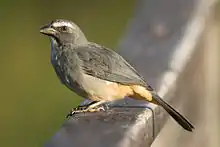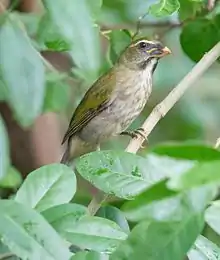Saltator
Saltator is a genus of passerine birds in the tanager family Thraupidae that are found in Central and South America. They have thick bills, relatively long tails and strong legs and feet. Before the introduction of molecular genetic methods in the 21st century these species were placed in the cardinal family Cardinalidae.
| Saltator | |
|---|---|
 | |
| Greyish saltator Saltator coerulescens | |
| Scientific classification | |
| Kingdom: | Animalia |
| Phylum: | Chordata |
| Class: | Aves |
| Order: | Passeriformes |
| Family: | Thraupidae |
| Genus: | Saltator Vieillot, 1816 |
| Type species | |
| Saltator maximus | |
| Species | |
|
Presently some 14, but see text. | |

Taxonomy

The genus was introduced by the French ornithologist Louis Pierre Vieillot in 1816 with the buff-throated saltator as the type species.[1][2] The name is from the Latin saltator, saltatoris meaning "dancer".[3]
The saltators were traditionally grouped with the cardinals, either in the subfamily Cardinalinae within an expanded Emberizidae[4] or in a separate family Cardinalidae.[5] Molecular phylogenetic studies have shown that the saltators are embedded within the tanager family Thraupidae. Within the Thraupidae the genus Saltator is now placed with the genus Saltatricula in the subfamily Saltatorinae. The relationship of the subfamily to the other subfamilies within the Thraupidae is uncertain.[6][7]
Species
The genus contains 14 species:[7]
| Image | Common Name | Scientific name | Distribution |
|---|---|---|---|
.jpg.webp) | Orinoco saltator | Saltator orenocensis | Venezuela |
 | Green-winged saltator | Saltator similis | Argentina, Bolivia, Brazil, Paraguay, and Uruguay |
 | Greyish saltator | Saltator coerulescens | from Mexico through Central America into southern South America, south to Peru and the Paraná River region in northern Argentina. |
.jpg.webp) | Streaked saltator | Saltator striatipectus | Colombia, Costa Rica, Ecuador, Guadeloupe, Panama, Peru, and Venezuela. |
 | Lesser Antillean saltator | Saltator albicollis | Dominica, Martinique, Saint Kitts and Nevis, and Saint Lucia. |
.jpg.webp) | Buff-throated saltator | Saltator maximus | southeastern Mexico to western Ecuador and northeastern Brazil. |
.jpg.webp) | Black-winged saltator | Saltator atripennis | Colombia and Ecuador. |
 | Black-headed saltator | Saltator atriceps | central Mexico to eastern Panama. |
 | Black-cowled saltator | Saltator nigriceps | Ecuador and the northern border region of Peru. |
.jpg.webp) | Black-throated grosbeak | Saltator fuliginosus | Atlantic Forest in far northeastern Argentina (Misiones), eastern and southeastern Brazil, and far eastern Paraguay |
 | Slate-coloured grosbeak | Saltator grossus | the Amazon in South America, but it is also found in forests of the Chocó in Ecuador and Colombia, and southern Central America from Panama to Honduras. |
.jpg.webp) | Masked saltator | Saltator cinctus | southern Colombia, Ecuador, and Peru. |
%253B_Urupema%252C_Santa_Catarina%252C_Brazil.jpg.webp) | Thick-billed saltator | Saltator maxillosus | Atlantic Forest in southeastern Brazil, far northeastern Argentina (only Misiones Province), and perhaps far eastern Paraguay. |
 | Golden-billed saltator | Saltator aurantiirostris | Argentina, Bolivia, Brazil, Chile, Paraguay, Peru, and Uruguay |
The rufous-bellied mountain saltator was formerly a member of this genus. It is now placed in the subfamily Thraupinae and is the only member of the genus Pseudosaltator. Its common name has been changed to rufous-bellied mountain tanager.[7] The black-throated saltator was also formerly assigned to this genus. It is now placed together with the many-colored Chaco finch in the genus Saltatricula as the two species form a divergent clade that is sister to the other members of Saltator.[7]
References
- Vieillot, Louis Jean Pierre (1816). Analyse d'une Nouvelle Ornithologie Élémentaire (in French). Paris: Deterville/self. p. 32.
- Paynter, Raymond A. Jr, ed. (1970). Check-list of Birds of the World. Volume 13. Cambridge, Massachusetts: Museum of Comparative Zoology. p. 228.
- Jobling, James A. (2010). The Helm Dictionary of Scientific Bird Names. London: Christopher Helm. p. 346. ISBN 978-1-4081-2501-4.
- Paynter, Raymond A. Jr, ed. (1970). Check-List of Birds of the World. Volume 13. Cambridge, Massachusetts: Museum of Comparative Zoology. p. 228.
- Committee on Classification and Nomenclature (1998). Check-list of North American Birds (PDF) (7th ed.). Washington, DC: American Ornithologist's Union. p. 631. ISBN 1-891276-00-X.
- Burns, K.J.; Shultz, A.J.; Title, P.O.; Mason, N.A.; Barker, F.K.; Klicka, J.; Lanyon, S.M.; Lovette, I.J. (2014). "Phylogenetics and diversification of tanagers (Passeriformes: Thraupidae), the largest radiation of Neotropical songbirds". Molecular Phylogenetics and Evolution. 75: 41–77. doi:10.1016/j.ympev.2014.02.006.
- Gill, Frank; Donsker, David; Rasmussen, Pamela, eds. (July 2020). "Tanagers and allies". IOC World Bird List Version 10.2. International Ornithologists' Union. Retrieved 19 November 2020.
Further reading
- Chaves, J.A.; Hidalgo, J.R.; Klicka, J. (2013). "Biogeography and evolutionary history of the Neotropical genus Saltator (Aves: Thraupini)". Journal of Biogeography. 40 (11): 2180–2190. doi:10.1111/jbi.12150.
- Echeverry-Galvis, María Ángela; Córdoba-Córdoba, Sergio (2006). "Descripción del huevo del saltátor collarejo (saltator cinctus) y comentarios preliminares sobre huevos del género saltator" (PDF). Boletín de la Sociedad Antioqueña de Ornitología (in Spanish). 16 (1): 76–84.
- Hellack, Jenna J.; Schnell, Gary D. "Phenetic analysis of the subfamily Cardinalinae using external and skeletal characters" (PDF). Wilson Bulletin. 89: 130–148.
External links
| Wikimedia Commons has media related to Saltator. |
- Saltator videos, photos & sounds on the Internet Bird Collection